Hosted by Melanie Medina, Event Manager at Association of California Water Agencies
The webinar was presented by Stem experts Zach Einterz and Pouyan Farzanehkariwho have over 25 years of energy experience between them. The agenda included:
- About Stem
- Use cases for battery storage
- Evaluating successful energy storage projects
- Case studies of water & wastewater treatment plants
Why partner with Stem?
Stem is a global leader in AI-driven energy storage and optimization with the first pure play solution that is currently publicly traded on the New York Stock Exchange. After acquiring AlsoEnergy this year, Stem has over 500 employees and has been one of the top storage providers in California for over a decade, with significant experience working with water agencies. Stem has unmatched expertise in the California storage market with both front-of-the-meter and behind-the-meter energy storage use cases.
Stem’s view is that energy storage and in particular, battery storage, is key to the grid transformation that we’re currently undergoing right now where we’re seeing what used to be a very centralized utility grid become much more distributed and renewable. As renewable energy adoption increases, battery energy storage is going to be a key component of stabilizing the grid. Stem uses advanced artificial intelligence (AI)-driven software, Athena®, to optimize the various distributed energy resources. They include battery energy storage, electric vehicle (EV) charging, and solar – allowing all of these resources to work together and to provide optimal benefits both to end users as well as to project developers, utilities, and the grid as a whole.
Stem’s services span the range of the project lifecycle, so we get involved in the early stages, where we help our partners design and determine the right configuration of energy storage projects for their particular goals. We also assist with deployment through our supplier relationships with top battery suppliers such as Tesla, SYL, Powin, and Sungrow.
We also assist in project management to help our customers and partners work through interconnection permits as well as local permits. Finally, we operate the system. This is usually the longest part of the life cycle, up to 20 years, during which Athena AI optimizes the battery energy storage system, delivering as much revenue as possible. Outside of that software layer, we also have a dedicated support team that includes both the Network Operations Center (NOC) as well as a program operations team that is working to make sure the system is operating as intended.
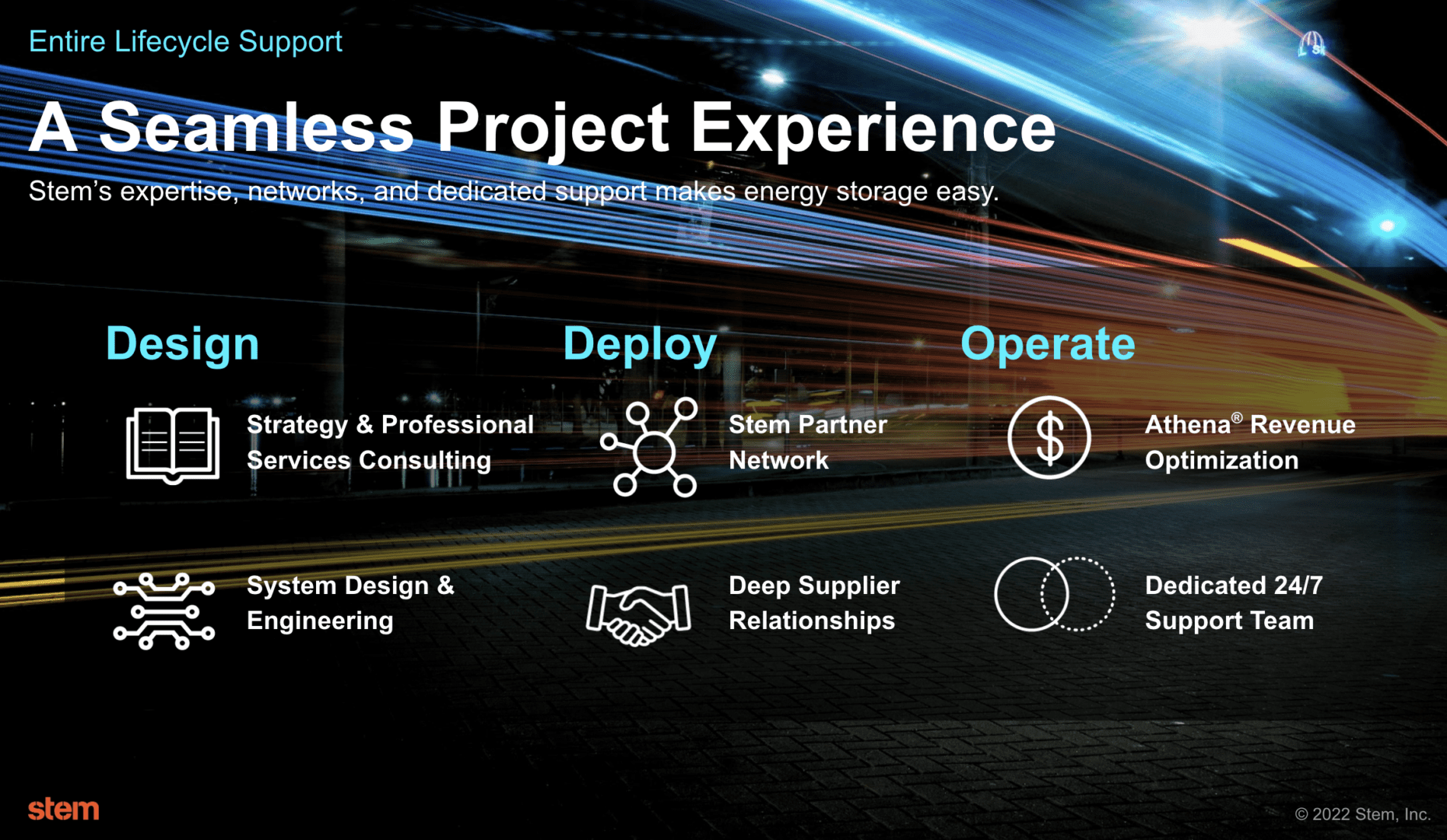
Athena drives better results
One thing that really differentiates Stem is our Athena energy software platform. Energy storage is very sophisticated as an energy asset, especially when compared to something like solar PV. When solar PV is deployed, it’s going to generate energy when the sun is shining but there’s not much that you have to do other than some cleaning and maintenance. In contrast, energy storage is very complex, where you need to monitor and control it on a minute-by-minute basis, making sure in real time that it’s charging and discharging as needed to optimize the value to the grid and to the host facility. Athena collects millions of data points from customer loads, utility tariffs, solar generation, and utility requirements around demand response programs and revenue opportunities. Athena’s AI then determines the optimal operating schedule for the battery. What we’ve seen is that having a sophisticated software layer can drastically improve the savings that the battery delivers to the customer.
Some water districts have experienced an 80% increase in savings after their project was operated by Stem.
Use cases for energy storage
Stem recognizes that water agencies across the state are stressed for a number of reasons. The drought is weighing on everyone’s mind, but from an energy perspective, there are a lot of challenges. For example, we’ve seen an increase in public safety power shut offs (PSPS) over the past several years, spurred by the wildfires we’ve had and the need for the utilities to mitigate that and we know that fairly impacts a lot of infrastructure especially since it tends to be in some of the more remote areas of California.
Another challenge in addition to wildfires, is increasing statewide targets for energy resiliency at a local utility-level. CCAs, especially, all have very aggressive targets for renewable energy, and they are looking for large energy users with water districts and water treatment plants to help them achieve their goals. Energy storage can address a lot of the challenges that water agencies face: energy resilience as a backup power solution, integration of renewable energy, and lower overall utility bills.
Standalone Storage
There are a couple of different ways that an energy storage system can be configured at a facility, including a standalone storage system, and what we mean by that is, a storage system that is not paired with solar or any other distributed asset. A standalone energy storage system can provide a lot of value to a facility primarily by discharging energy when it’s most valuable and storing energy when it’s least valuable and saving it for when it is valuable. Through energy arbitrage and reducing demand charges, a standalone storage system can provide a lot of value to a customer.
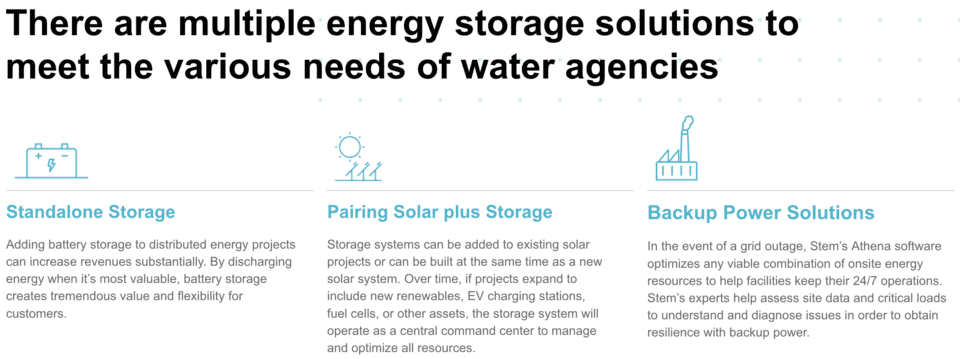
Pairing Solar + Storage
In addition to Standalone Storage, you can also pair Solar + Storage. The advantage to that is, when storage is charged by solar, it can qualify for a Federal investment tax credit, which in effect lowers the overall project costs. Another advantage is that it helps to smooth out that intermittent renewable resource and allows you to store that extra solar energy for the time when it is most valuable.
Backup Power Solutions
Finally, storage can also be configured as a Backup Power Solution. That is something that we see as particularly valuable for creating critical infrastructure like water plants.
One of the main reasons that Stem customers choose to deploy storage is the fact that they have financial value as shown in the value stack below.
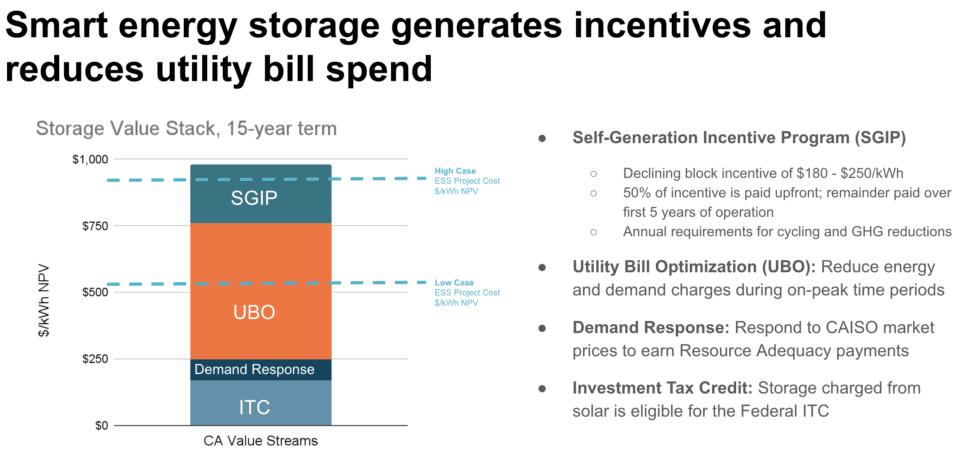
Reducing greenhouse gas emissions
A unique aspect about storage is that it is a dynamic and dispatchable asset that can augment the greenhouse gas (GHG) emissions sought from solar. While solar certainly helps reduce emissions, it only does it during a certain part of the day, and oftentimes we see that the periods of the day that have some of the highest emissions on the grid actually occur after solar has stopped generating in the late afternoon and evening time periods. Stem’s Athena software will optimize reducing GHG emissions for you.
How Stem evaluates storage systems
There are different elements when evaluating storage systems. The financial evaluation is the first step to determine electricity cost before and after storage installation and includes key financial projections. There is the actual hardware, the Battery Energy Storage System (BESS) evaluation that Stem evaluates through RFPs and track their warranty and a review of the purchasing contracts and negotiations. Today, we work with top tier 1 suppliers – including Tesla, Sungrow, Powin, and SYL. Read more Stem’s vetting of hardware suppliers to keep the supply chain and project scheduling on track.
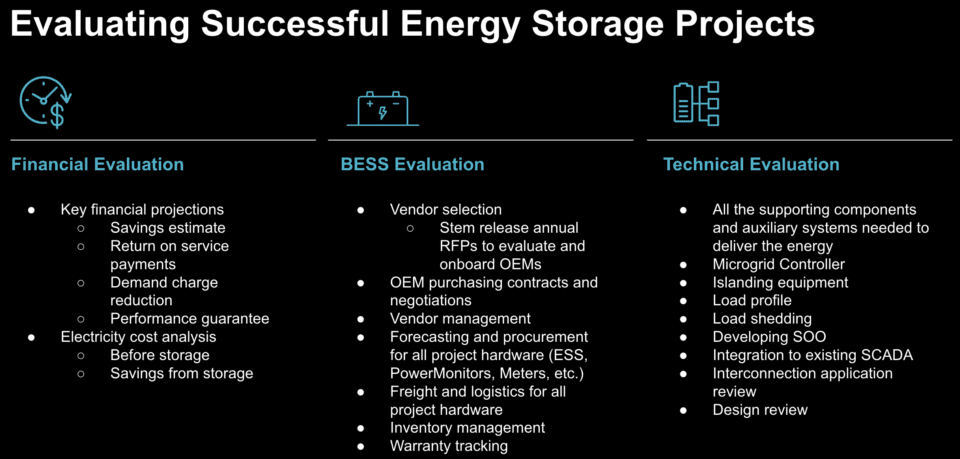
Additional information in the webinar includes a discussion on how Stem will partner with water agencies to install Private Microgrids and how Backup & Resilience Configurations work as shown in the diagrams below.
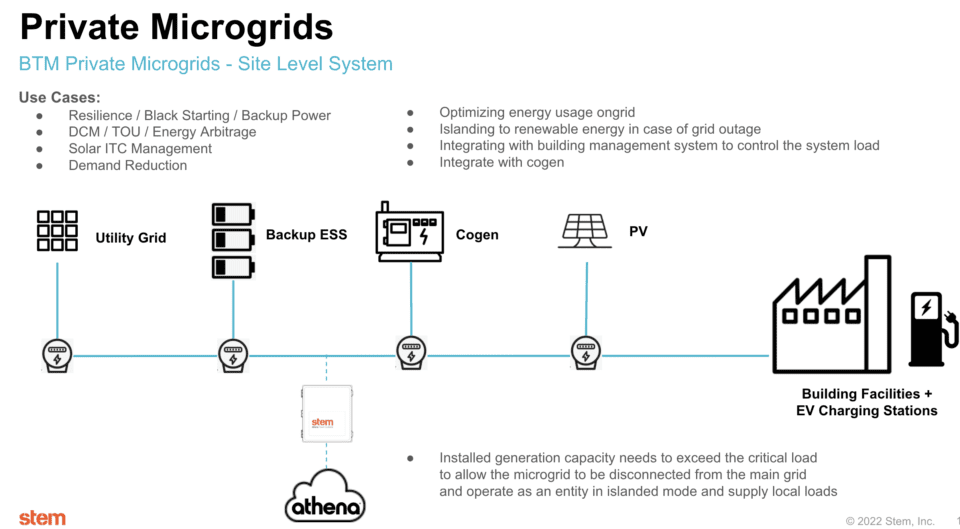
For in-depth details and the Q&A, watch the webinar on demand.
Additional Resources
- Energy Resilience Solution Overview
- Solar plus Storage Solution Overview
- Utility Bill Optimization Solution Overview
- Microgrid FAQ Blog
- California SGIP One Pager
- How CA Facilities Can Get Paid for Avoiding Power Outages Blog
- Orange County Sanitation District Case Study
- Lake Arrowhead Sanitation District Case Study
To get started with Stem, complete the Let’s Talk form below.